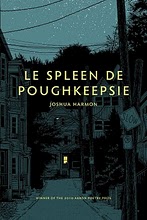
|
“The automatic garage-door opener / lifts on a prospect of Poughkeepsie,” and Joshua Harmon’s tender, disturbing catalogue of “the secret / city inside the more obvious one” has, like a recession, already set into motion its “insufferable inching towards wreckage.” Reimagining Baudelaire’s turbulent investigation of the horrific transformations of mid-19th century Paris, Harmon sets his syntactical abilities on Poughkeepsie, a failing town on the Hudson River that was once a burgeoning center of culture, industry, and politics that is, like so much of the American landscape, a crumbling, rusting visage of its former self. Everywhere we go in these poems, the town, the people, and the landscape carry the physical and emotional scars of their decaying fate, a bleakness that is smelted to the particulars of its existence. Hope is hard to come by as “an autistic rain stutters over Poughkeepsie” where “the sky is pink over a block of derelict homes in the city / where I can’t look at you alone.” And there is music in Poughkeepsie, and Harmon makes us listen: …the noise of beauty, The human and the nonhuman have literally collided, violence has become a casual response to questions no one can answer, and the myth of what it means to be from a town like Poughkeepsie has been dismantled with “another boombox sermon” as “imaginary / municipalities of strip mall treelines get knocked over / with a front-end loader.” Harmon spares nothing, and his grief, and Poughkeepsie’s grief, are made new in his language, which is frightening: “the girl hiding beneath her bed for hours / thinks it’s going to end / but it never ends.” In dialogue with Baudelaire, who was appalled by the intensification of the inhuman forces of modernization, especially by its effects on the poor, Harmon is witness to the shocking aftereffects of what it means to forget that we are human, and that our ability to ruin the environment and ourselves can so easily escape our control. Through Harmon’s precise, charged enjambments and attention to syntax, these poems blur class, nature, language, technology, and the remnants of mercy into a post-pastoral fight for survival. …progress’s ordinary commerce and intervening scraps: so noise windwardly amid the working vocal inflections and muttered rebuilding the house they That Le Spleen de Poughkeepsie oscillates between meditative prose blocks, fiercely enjambed lyrics, and unbroken, longer poems is another testament to Harmon’s control over language and content. Throughout these poems, a divergent, untranslatable language emerges from the structures of Poughkeepsie via “the mumble of traffic” and “the passive voice / [that] speaks on our winds and in the humming / of our truck tires,” resulting in poems that are a kind of “textual weeping.” Indeed, Poughkeepsie inhabits the language of these poems in many ways: “From a nest inside the illuminated O on a strip mall’s façade, a starling watches too.” Amid such syntactical despair, these poems are still able to resurrect a buried optimism unique to lost places like Poughkeepsie. Even the image of “a feral kitten licking coconut milk / cans left unrinsed in the recycling bin” carries a buoyant kind of hopefulness. It’s surprising when Harmon writes that “[t]he greatest poverty is not to live / in Poughkeepsie,” but it’s clear there is strength to be found in such brokenness, that the future is still there, empty as it may seem. how long till you succumb But not everyone will make it out: “the ritual mourners of Poughkeepsie / find the rock-salt path home.” For a little while, Harmon makes it worth it to follow them, to show their faces, so much like yours. --Nick Sturm
Nick Sturm is a graduate student in the NEOMFA: Northeast Ohio Master of Fine Arts. Winner of the 2011 AWP Intro Journals Award, his reviews and interviews have appeared or are forthcoming in Coldfront, H_NGM_N, The Laurel Review, On the Seawall, and Whiskey Island. His first book-length editorial venture, The Monkey and the Wrench: Essays into Contemporary Poetics, was published by the University of Akron Press in January 2011. Also by Nick Sturm: Review of Come On All You Ghosts by Matthew Zapruder
|
